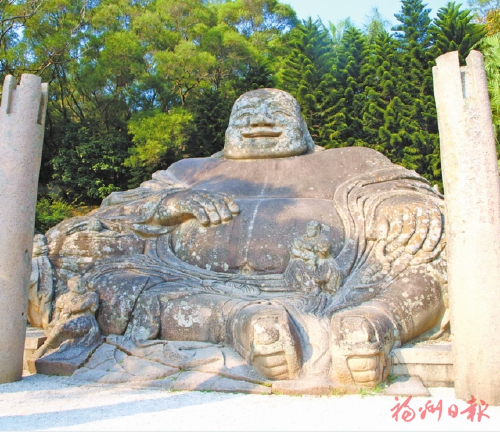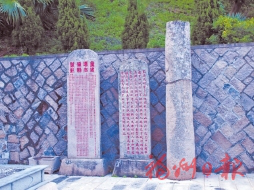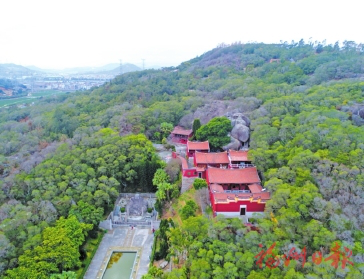Ruiyan Maitreya Statue: Living Fossil of Diversified Coastal Culture
2020-03-16 15:16:26
Reported by Qian Jiayi
2020.03.16
March 16, 2020

Ruiyan Maitreya Statue. (Photo courtesy of the Publicity Department of the CPC Fuqing Municipal Committee)
FUZHOU, March 16 (Fuzhou Daily) – Setting out from the downtown area of Fuqing City and driving about 10 kilometers eastwards, one can reach Ruiyan Hill, a scenic area featuring grotesque rocks and deep caves. At the foot of Maitreya Rock, a gigantic statue of the Buddha sits with his legs crossed. It is the well-known Ruiyan Maitreya Statue. The lifelike statue boasts superb craftsmanship, fluent lines and exquisite design, and bears unique memories of the integration and development of diversified religious culture at the peak time of Buddhism in Chinese coastal towns.
Discovery records
The Ruiyan Maitreya Statue, located in the front of Ruiyan Hill in Niuzhai Village, Haikou Town, Fuqing City, is the largest statue of Maitreya Buddha in a sitting posture in China as well as the biggest Buddhist statue of the Yuan Dynasty (1271-1368) in Fujian Province. It is dubbed as one of the “Two Stone Carving Masterpieces of Ancient Fujian” together with the Lao-tzu Statue of the Song Dynasty (960-1279) in Qingyuan Hill, Quanzhou City. The Ruiyan Maitreya Statue has been approved to be a major monument protected at the national level.
The statue was constructed during the Zhizheng reign of the Yuan Dynasty. Several natives of Fuqing including Lu Bogong organized artisans to carve the statue according to the natural appearance of the rock. In 1390, the 23rd year of the Hongwu reign of the Ming Dynasty (1368-1644), Monk Wupu built a hall to shelter the statue, which was reconstructed in 1583, the 11th year of the Wanli reign. In 1620, the first year of the Taichang reign, Ye Xianggao raised funds to rebuild the hall and construct another building called Kuixing Tower. The entire architectural complex was named Shifo (Stone Buddha) Pavilion. In 1862, the first year during the reign of Emperor Tongzhi of the Qing Dynasty (1644-1911), the Shifo Pavilion was destroyed, with only 10 stone pillars and three stone tablets preserved to this day.

▲Stone tablets beside the Ruiyan Maitreya Statue. (Photo courtesy of the Publicity Department of the CPC Fuqing Municipal Committee)

▲Ruiyan Hill Scenic Area. (Photo courtesy of the Publicity Department of the CPC Fuqing Municipal Committee)
Historical origin
A fruit of sinicization of Buddhism in Sino-foreign cultural exchanges
Narrator: Wang Liming from the Division of Cultural Relics and Museology of Fuqing Municipal Department of Culture, Sports and Tourism
The Ruiyan Maitreya Statue is a rare masterpiece among large stone carvings in China. It is 6.8 meters tall, 8.9 meters wide and 8 meters thick. The head measures 2.3 meters from top to bottom, with the top extending 1.8 meters in width. Each ear is 1.3 meters long, and the mouth is 1.1 meters wide. The stone Maitreya Buddha looks kind and amiable, with his eyes looking at the front horizontally, his ears dropping down to the shoulders, his chest and abdomen naked, and his legs crossed. He holds a string of prayer beads in his left hand, and touches his upper belly with his right hand. He laughs with his mouth wide open, and embraces three small arhats, including two in sitting posture, each measuring 0.8 meters tall and 0.4 meters wide. The rest only has his head and hands exposed, and looks lifelike and adorable.
According to Special Records of Seaports, the Ruiyan Maitreya Statue was chiseled on the basis of an entire natural rock by artisans recruited by Lu Bogong, a native of Fuqing. It is said that the statue cost 100 artisans working for years under the instruction of stone carving masters.
Why is Maitreya Buddha often depicted with his chest and belly naked and his mouth wide open in laughing? Legend goes that Maitreya often traveled to practice Buddhism. One day, he met two men, one of whom said to him, “I was told that you’re a generous person and often help people in need. So, could you give me your upper garment?” Maitreya saw the man half-naked and then took off his upper outfit to give him. Seeing he was so generous, the other man asked, “My pants were broken, could I borrow yours?” Maitreya thought he should satisfy this man’s request as well, so he took off his pants. At the moment, a woman passed by. To hide his embarrassment, Maitreya immediately sat down on the ground, laughing while covering his naked belly with his hands. A poem goes that “Being bare-chested is not an expression of arrogance and haughtiness; a noble person needs not to care too much about his appearance.” This is the reason why Maitreya Buddha is often seen bare-chested.
Three stone tablets stand beside the statue of Maitreya Buddha in Fuqing City. They bear inscriptions that record about Monk Wupu raising money to build Shifo Pavilion in 1390 (the 23rd year of the Hongwu reign of the Ming Dynasty), about Ye Xianggao raising funds to rebuild Maitreya Pavilion in 1583 (the 11th year of the Wanli reign) and about subsequent reconstructions. According to Records of Ruiyan Hill, the Maitreya Pavilion featured stone pillars and a wooden roof and had openings in four directions, but it collapsed in 1862, the first year during the reign of Emperor Tongzhi of the Qing Dynasty. Today, only 10 mutilated stone pillars remain, on which are carved with the names of donators and couplets reading “Wish the heaven fosters good more people; wish the people do more good deeds; wish the world a peaceful place.”
It is noteworthy that the Maitreya Statue of Fuqing is strikingly different from the appearance of Maitreya introduced from ancient India during the Jin Dynasty (266-420). At that time, Maitreya looked like an Indian national with a high nose bridge and a slim face. However, the Maitreya Statue of Fuqing features a potbelly, a round belly and a round face with a flat nose bridge and tall cheekbones, just like a typical Chinese monk. Apparently, the statue is a fruit of sinicization of Buddhism in cultural exchanges with other countries.
Protection and inheritance
Strong folk foundation and characteristics
The protection of the Ruiyan Maitreya Statue can be traced back to 1973, when the government allotted special funds to build a stone wall to encircle the statue and an earth-retaining stone foundation. The 10 remained stone pillars of the ancient Shifo Pavilion near the statue, including six in the front, two on the two sides, and two in the rear, are preserved. In addition, there are also three stone tablets in front of the statue.
For the need of renovation, upon the approval of the National Cultural Heritage Administration, the Fujian Museum carried out an archeological excavation of the foundation of the Shifo Pavilion and made rubbings of the inscriptions on the two stone tablets in front of the statue in 1997. The findings during the excavation provided references for further conducting protection and renovation of the statue and exploring its historical connotations.
The excavation report showed that constructors of the Shifo Pavilion recorded in the inscriptions were actually organizers of relevant construction projects, and the pavilion was a result of concerted efforts of local residents, who not only contributed manpower but also donated money and materials such as stone pillars. According to historical records, the reconstructed Shifo Pavilion had “46 stone pillars, and its width and depth added up to 18 zhang (60 meters).” The magnificent structure was popularly known as the “Paradise of Maitreya,” testifying to the significant position of the stone statue in the minds of local people in Fuqing.
In terms of cultural heritage protection, Fuqing established the Maitreya Rock Scenic Area, putting the Maitreya Statue under unified planning and protection together with local historical tales as well as nearly 100 inscriptions by Qi Jiguang, a famous general known for fighting Japanese pirates in the Ming Dynasty, Ye Xianggao, a scholar and high-ranking official of the Ming Dynasty, and other historical celebrities such as Lin Ruzhu, Xu Xiake and Chen Jingbang. With the enrichment of its historical and cultural significance and the increase of its reputation, the statue has drawn greater attention and received better protection.
Expert comment
Mao Yinyun, curator of Fuqing Museum
The exquisitely carved Ruiyan Maitreya Statue is lifelike both in shape and spirit and demonstrates a strong realistic and sinicized style. The statue displays three major characteristics: First, the characteristic of the times. As the largest existing stone statue of Maitreya Buddha dating back to the Yuan Dynasty, it is considered a typical embodiment of the secularization and sinicization of Buddhism; Second, regional characteristic. The statue not only manifests the integration and development of diversified religious culture in coastal towns of Fujian during the peak time of the Song and Yuan dynasties, but has also witnessed cultural exchanges between different regions in China and showcases the superb craftsmanship of Fujian stone carving and local artisans’ unique utilization of materials; Third, the characteristic as a living fossil. The Maitreya Statue is closely associated with local cultural traditions and religious activities, and its physical state and religious function are well-preserved to this day.